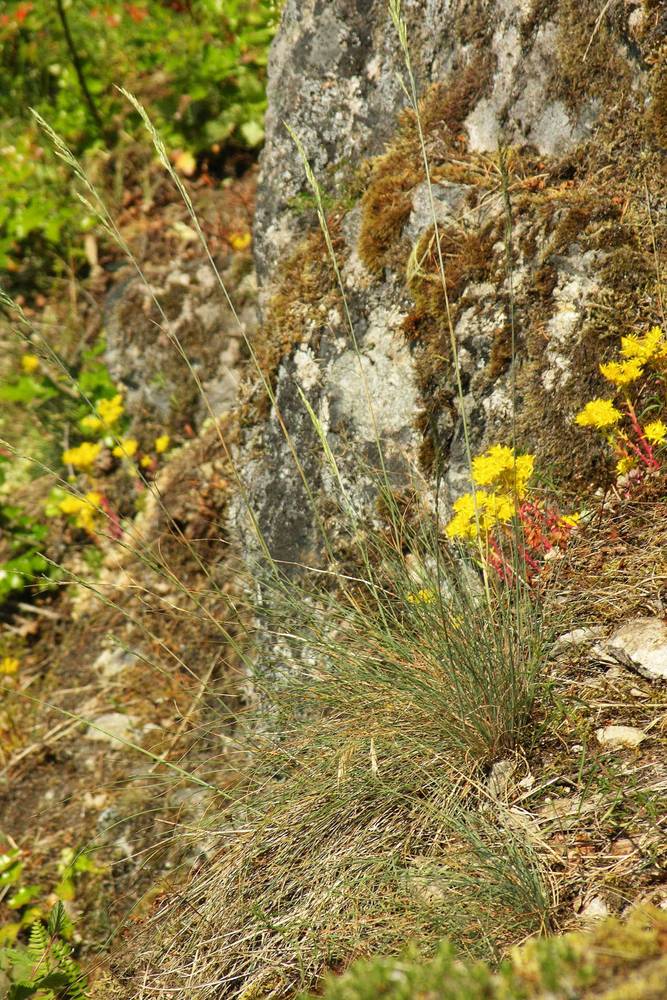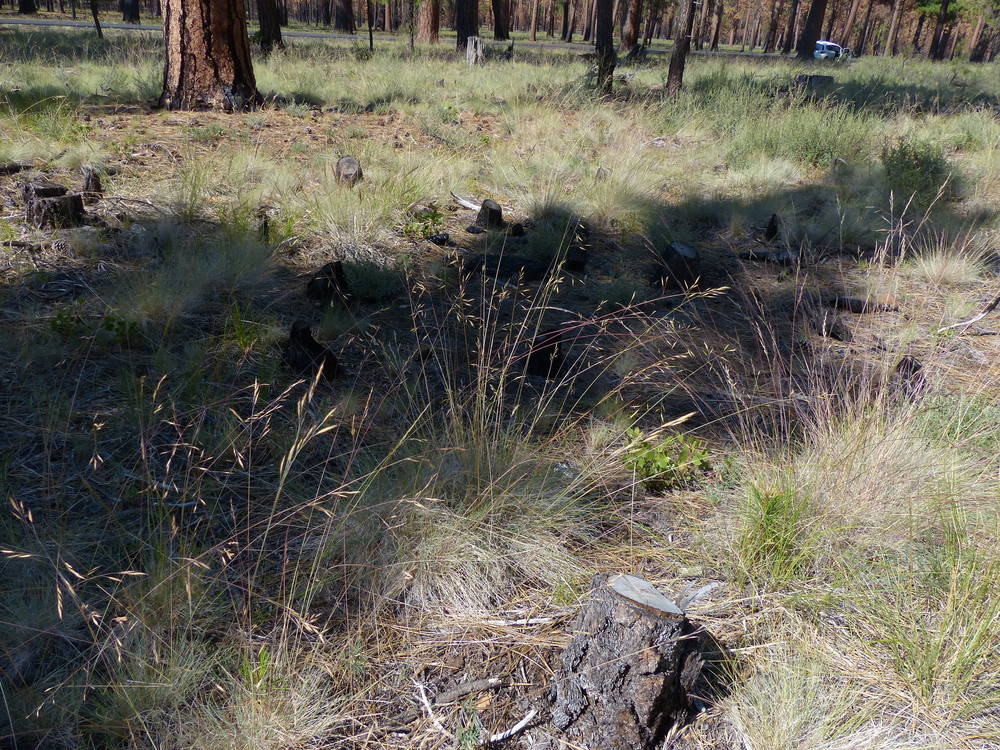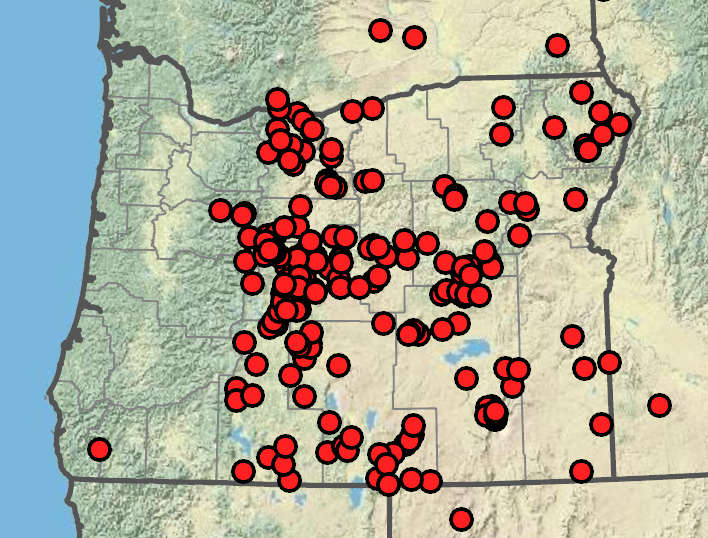Festuca roemeri
Festuca idahoensis
Roemer's fescue
Idaho fescue
basal branching intravaginal.
basal branching intravaginal.
mainly basal;
sheaths open, glabrous but sometimes hairy, not conspicuously splitting between the veins, usually pale, becoming gray-brown with age;
collars glabrous;
ligules 0.1–0.4 mm;
blades 15–35 cm × 0.5–1.2(2.5)mm, conduplicate or occasionally flat;
outer surface usually glabrous, sometimes hairy;
inner surface glabrous, scabrous; hairy; flag leaves 7–12(18) cm.
mostly basal;
sheaths open, glabrous to hairy, usually pale (white, pink, light brown) and lacking contrasting veins, crumbling or somewhat splitting between the veins but not shredding;
blades readily spinning between the fingers;
collars glabrous;
ligules 0.3–0.6 mm;
blades (5)8– 25(35)cm × 0.3–1 mm as folded, conduplicate, usually glaucous, sometimes green;
outer surface scabrous, sometimes with long hairs;
inner surface with hairs about as long as the leaf is thick; flag leaves (1.5)3–7(9.5) cm, usually conduplicate, sometimes loosely rolled.
(8)10–20(25)cm;
branches 3–7 cm, ascending to reflexed at anthesis, appressed after anthesis or sometimes the lowest spreading to reflexed.
s (5)7– 12(20) cm; open at anthesis; lowest node with 1–2 branches;
branches (5.8)7.5–17(19)mm, ascending to reflexed at anthesis, appressed after anthesis or the lower branches sometimes remaining spreading to reflexed.
9.5–12(13.5)mm, 3–6 florets.
(5.8)7.5–17(19)mm, with (2)3–7(9) florets.
glabrous or scabrous to short-hairy at the tip only;
lower glumes 2–5 mm, 1-veined;
upper glumes 4–5.5(6.2)mm, 3-veined.
glabrous or hairy at the tips only;
lower glumes (2.5)3–5(6)mm, 1–3-veined;
upper glumes (3)4–8 mm, 3–4-veined.
glabrous.
4–4.5 mm, glabrous.
apex glabrous.
apex glabrous.
cross sections usually 0.4–0.8 × 0.75–1.2 mm, elliptic or L-shaped;
veins (5)7(10);
ribs 5(9); dorsal sclerenchyma bands more than 2 times wider than thick, sometimes restricted to the midrib and margins only.
cross sections 0.35–0.6 × 0.55– 0.7 mm; more or less round or hexagonal;
veins (4)5(6);
ribs (1)3(5); dorsal sclerenchyma in broad bands more than twice as wide as thick, occasionally continuous.
3–5 mm.
(2.5)3.2–4(4.5) mm.
(5.8)6.5–8.2 mm, 0(5)-veined, with hairs on the distal part only;
lemma awns 2–4(5)mm; shorter than or as long as the lemma body.
(5.8)6–8(10)mm, 0(1)-veined;
hairs on the distal part only;
lemma awns (1)2–6(7) mm; shorter than to occasionally equaling the lemma body.
=28.
=28.
Festuca roemeri
Festuca idahoensis
2 varieties.
Festuca roemeri is most often confused with the bunchgrass forms of F. rubra. Festuca rubra leaves are smooth, the sheath margins are fused, and bunchgrass forms of F. rubra usually have shorter lemmas. In cross section, leaves of sterile shoots of F. rubra are diamond shaped to triangular, angled next to the largest lateral veins. The leaf sclerenchyma bands are less than twice as wide as thick. Festuca roemeri is closely related to F. idahoensis, and intermediate plants can be found where the ranges of the two species come into contact at the east end of the Columbia Gorge, in the High Cascades, and in Klamath County. Festuca idahoensis has round to hexagonal leaves that spin readily between one’s thumb and forefinger. Festuca roemeri leaves usually won’t roll, though leaves from very dry serpentine sites will roll but with the angles easily felt. Festuca trachyphylla and F. valesiaca have smaller lemmas and denser inflorescences. Vegetative F. valesiaca cannot be distinguished from F. roemeri.
Prairie, grassland, shrub-steppe, open pine forest, often in partial shade or on north-facing slopes; also on south-facing slopes in subalpine and alpine zones. 100–3000 m. BR, BW, Casc, Col, ECas, Lava, Owy. CA, ID, NV, WA; north to British Columbia, northeast to Saskatchewan, SD, and NM. Native.
Festuca idahoensis is the most common fine-leaved fescue east of the Cascades. However, very similar fescues have been introduced. Festuca trachyphylla and F. valesiaca, planted on roadsides and used to renovate dry pastures, have shorter lemmas and denser inflorescences. Robust individuals of F. occidentalis can be similar to F. idahoensis, but in F. occidentalis many of the lemma awns are longer than the lemmas. In alpine sites, F. idahoensis can be confused with F. brachyphylla and F. saximontana, which have shorter lemmas. Plants west of the crest of the Cascades that were once included in F. idahoensis are now recognized as a distinct species, F. roemeri, which has broader leaves than F. idahoensis.
Barbara Wilson, Richard Brainerd, Nick Otting
Barbara Wilson, Richard Brainerd, Nick Otting
- Local floras:
BC,
CA,
OR,
WA
- Local Web sites:
CalFlora,
CalPhotos,
Flora NW,
PNW Herbaria
WildflowerSearch
iNaturalist (observations)
USDA Plants Database
- LBJ Wildflower Center
- SEINet
- Plants of the World Online
- Encyclopedia of Life
- Wikipedia
- Google Image Search
- Local floras:
BC,
CA,
OR,
WA
- Local Web sites:
CalFlora,
CalPhotos,
Flora NW,
PNW Herbaria
WildflowerSearch
iNaturalist (observations)
USDA Plants Database
- LBJ Wildflower Center
- SEINet
- Plants of the World Online
- Encyclopedia of Life
- Wikipedia
- Google Image Search





